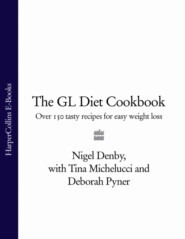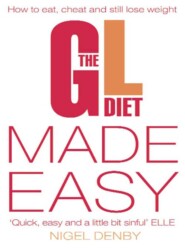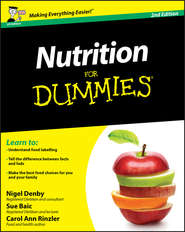По всем вопросам обращайтесь на: info@litportal.ru
(©) 2003-2024.
✖
The 7-Day GL Diet: Glycaemic Loading for Easy Weight Loss
Автор
Год написания книги
2019
Настройки чтения
Размер шрифта
Высота строк
Поля
A Word about Goal Setting
Take some measurements before you begin the diet so you can see how much weight you lose.
It’s useful to know your BMI (body mass index). No weight-for-height charts are perfect but we prefer the BMI because it gives you an indication of the risk to your health from your weight. It’s also useful because there is a wide range for each classification, and for people with a lot of weight to lose it’s really helpful in setting staged targets. It’s important to remember, though, that the BMI is a guide, not the Holy Grail.
For your reference there is a BMI chart on our website. There is good evidence that having a BMI of 20–22 has greater health benefits than a BMI of 23–25. However, we wouldn’t recommend that you try to achieve a BMI of less than 18.5.
If your current BMI is between 20 and 25 then you really don’t have a huge amount of weight to lose. You can probably expect a weekly weight loss of about 2lb as it tends to be slower the less you need to lose. If your BMI is between 25 and 30 you’ll lose a little more each week, and if your BMI is above 30 then it wouldn’t be unusual to lose more then 5lb in seven days, especially if you are able to be more active than usual, but check this first with your doctor.
It’s also a good idea to take some body measurements such as your waist, hips and bust or chest. Use a tape measure and make sure you measure the same spot each time. Keep the tape measure straight for the most accurate result.
To measure your waist – measure around the naval or belly button
For hips – measure at the widest point of your bottom
For bust or chest – measure around your nipples
If you are working on increasing your day-to-day activity levels then measurements will be especially important. You may well change shape and lose inches faster than you lose weight. This is because as you increase your activity level, you replace some fat with muscle, which weighs more than fat. Physical measurements, especially around the waist, are just as meaningful as actual weight changes. Besides, if your goal is to drop a dress size or get into jeans two inches smaller than your current pair, does it really matter how much you weigh? No, of course it doesn’t!
The more you move about, the less you’ll wobble
There’s more information about goal setting coming up in the next chapter.
Chapter 4 KOKO – KEEP ON KEEPING ON (#ulink_f1ece734-f3fb-57e9-831c-d0772364d763)
We talked in Chapter 3 (#ulink_2ad4bacc-831d-5a23-84fc-a39d37e70f90) about the importance of planning before you start your diet. Well, an integral part of the planning process is deciding what it is you actually want to achieve.
You might be thinking at this point: I’m reading a diet book, so I guess I just want to lose weight! I suspect that if we look a bit more closely at your motivations, we might find you’ve got quite a bit more to gain as well, and you can set goals for these outcomes too. You might want to feel more confident, be able to buy clothes more easily, lower your risk of heart disease, diabetes, cancer or other diseases, or improve your fitness. Of course your goal might be as simple as just wanting to get back into that dress or suit you haven’t been able to wear for ages.
Whatever you want for yourself, the art of goal setting is keeping it real and achievable, and also having performance measures or milestones along the way to let you know you are heading in the right direction.
We’ve been very careful throughout the book to keep our promises real and achievable, and we really want to encourage you to do the same with your expectations of yourself. If you set unrealistic, unachievable goals for yourself you also set yourself up for disappointment and failure, and we all know what that feels like from our past experiences of diets, don’t we?
Weight-loss Goals and Measuring Your Success
You may wish to find out your BMI (Body Mass Index) from the chart on our website. Remember, people with a BMI of between 20 and 25 should expect to lose no more than 2lb per week; people whose current BMI is between 25 and 30 could lose between 2 and 5lb per week; while people with a BMI higher than 30 may lose more than 5lb.
Weight loss is never consistent. No body loses the same amount of weight every week. So these guidelines are very much that – guidelines. A better way to look at weight loss, and the way I prefer to measure success with my patients, is to look at monthly weight loss. Taking three or four weight measurements during the month, and then averaging them over the full month, gives a much more accurate picture of what’s going on. This method also evens out those weeks when weight loss is disappointing with those when you’re walking on air because it’s all going so well.
Each time you weigh yourself, it’s important to use the same scales, and to weigh yourself at about the same time of day. This will prevent inaccuracies and also limit false weights from changes in fluid balance – we can weigh up to 4lb more at one end of the day just because we are holding more fluid – so same time, same equipment is a golden rule. When it comes to setting long-term targets for yourself, there are literally hundreds of options. We’ll look here at a few of the most important.
Weight Loss for Health
If you are quite overweight – let’s say your BMI is over 30 and you are dieting primarily for health reasons – then to set a goal of reaching a BMI of 20 might not be realistic. It may also be a goal that seems too far away right now, so it may not be that helpful in keeping you motivated. What might be more achievable would be to aim first of all to reduce your weight by 10 per cent. Let’s say you currently weigh 16 stones (224lb or 101kg). A 10 per cent weight reduction would be 1½ stones or 21lb or 10kg. The 10 per cent bit is very significant: good-quality studies have shown that reducing your weight by as little as 10 per cent significantly reduces your risk of heart disease, diabetes, high blood pressure, high cholesterol and some cancers – not to be sniffed at. Once you get to 10 per cent, aim for the next 10 per cent and so on. The health benefits just keep on coming.
Measurements
Measuring your waist, hips and bust or chest is another great way to chart your results. Fat carried around the tummy or abdomen is a key indicator for an increased risk of heart disease and diabetes. Aiming for a waist circumference that reduces your risk is a fantastic goal.
We’ve also included a measurement chart for you to complete, below. This will be particularly useful if you think you’d like to continue the diet for a few weeks. It’s a great motivator to let you know everything is moving in the right direction.
If you’re not sure how to take accurate measurements then have a look at our tips on page 39.
Other Measures of Success
As far as other measures of success go, the key is to record where you are right now, before you even start the diet, and then make appointments with yourself to revisit your list and review your progress. You can do this for feelings, emotions, confidence and a whole host of weight-connected issues. There’s much more to finding Diet Freedom than just what the scales tell you. You can score these feelings and emotions in a variety of ways. Words are good but if you find that difficult, try using the smiley face score or the scale of 1 to 10.
Smiley Face Score
Use the faces to represent how you feel for each feeling or emotion in the table below and watch your score get more and more smiley!
Scale of 1–10
Imagine a scale from 1 to 10, with 1 being the least confident or optimistic and 10 being the most confident or optimistic you could feel. Then give yourself a score for how you feel at that moment, and revisit the score table next week and the week after, and so on.
Scale of 1–10 for how you feel
1–2–3–4–5–6–7–8–9–10
1 = lowest
10 = highest
Keep a record of how you feel here:
Recording things other than your weight and physical measurements is a really motivating and important part of keeping you going. It might seem a bit strange to start with, but the more you do it, the easier it will become.
KOKO – Keep on Keeping on!
We’d love to take the credit for this phrase, but sadly we can’t. It started with our army of Diet Freedom Fighters who keep each other motivated and share tips on our website forums. They are a great place to start when it comes to KOKO. Dieting can be a lonely old business and it’s inevitable that you’ll have good days and days when it all seems a bit too much. Those can be really negative and send your motivation into a downward spiral. Sometimes a trouble shared really can be a trouble halved, and you can bet that someone else is either feeling exactly the same as you, or has been there before and can give you just the words of wisdom and encouragement you need to get you back in positive mode. We regularly call in to the forums to update everyone with new information and encouragement, so please do join us and meet some new friends to share support and ideas with.
A Lapse is a Slip, a Relapse is a Return to Old Ways …
Lapsing, ‘having a bad day’, ‘losing your focus’ or ‘falling off the wagon’ – whatever you want to call it – is a perfectly normal part of changing. It’s human nature to forget to have your morning snack occasionally, and end up choosing something unhelpful at lunchtime – that happens because you got too hungry to make a sensible choice, not because you have no willpower. Likewise, going to someone’s house for dinner and eating a meal which doesn’t quite fit in with low-GL principles is being polite, not weak willed. I have never worked with a patient who hasn’t had the odd slip here or there, and I don’t expect I ever will. If it were that easy to be perfect all of the time I doubt any of my patients would bother coming to see me, and you wouldn’t have bothered to buy this book!
A lapse becomes a problem when it triggers all kinds of negative thinking, feelings of hopelessness, complacency and guilt:
I’ve never had any willpower.
I always give in to temptation.
I’ve blown it.
I’m miserable – let’s eat – I’m even more miserable – let’s eat some more …
One biscuit won’t hurt.
That’s just the time when a lapse is in real danger of turning into a relapse, and within minutes you can be right at the end of that diet-trap cycle all over again. These are just the kinds of trick our negative dieting experience from the past likes to play on us. It’s the way our old behaviour tries to exert power over the new relationship we have with food. The unhealthy food behaviours we have learnt, and relearnt, to perfection every time we have tried to diet in the past, enforce the negative self-belief thoughts like these promote. Part of finding your Diet Freedom is facing these thoughts head-on and beating them. A critical part of the process is seeing a lapse for what it is, understanding why it happened, deciding if you would deal with the situation differently in the future and moving on. End of story.









